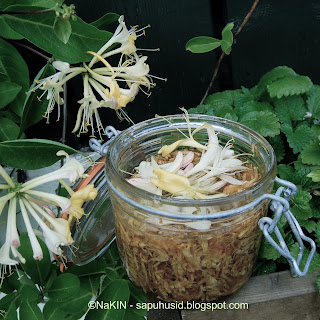Roses are wonderful plants. There are so many varieties that everyone can find somthing to like. My favorites are primarily roses that smell nice. I somehow find it incredulous that people actually grow roses that have no scent! If I had to choose a colour I would probably go for pink, but I also love very pale, white and beige. I intensely dislike the long stemmed red roses that are supposed to be so romantic. Overbred and sterile. But that's me.
Rugosa roses grow very well here up north. They are tough as old boots and produce an abundance of flowers and smell very nice. Hansa rose is a hybrid Rugosa that produces large fucshia pink flowers that have a strong scent. The hips are bright orange and I did gather quite many last fall to make rose hip jelly and sirup. This plant is very common and grows in many public spaces. I have a favorite spot where I go to gather roses in full bloom, before the petals start to fall down.
I have infused olive oil by letting petals sit for 24 hours or more, then squeezing out the oil (with my hands to get all the oil) and put in more petals and repeat the whole process. I've done this 3 times with fresh petal in the same oil and I have bit of lovely golden, nice smelling oil. This is like liquid gold. I have used it on my face, just straight from the bottle. I might make a face cream out of it, but probably not, it is lovely as a serum.
But the thing I'm even more excited about is the rose jelly. I have read recipes for this in Danish magazines for years, but never had enough roses from my own garden to do this. Now, with foraging in my secret place, I have an abundance of roses to use and here is this lovely recipe. And let me add that I never take so much that anyone would notice. And I only take the blooms that are fully open, but just before they start to wilt. It is just like deadheading the roses.
Rose jelly.
1 liter (about 1 quart) (hard packed) rose petals - using strong pink and red gives a lovely colour
I also threw in a handful of honeysuckle flowers because they were in flower - they soothe sore throats.
1 liter (1 quart) water
800 grams (slightly less than 2 pounds) sugar
20 g pectin (I used a commercial product called Melatin - yellow)
1 - 2 tbs lemon juice
The white pointy bit of the rose petals need to be cut off. A bit fiddly, but they have a bitter taste so it's better to remove them and get a pure rose taste.
The petals are then put in a saucepan with the water and a lid on and this is brought to a gentle boil. Push the rose petal into the water and simmer very gently under a lid for about 5 minutes. Leave to steep over night.
Siv out the spent petals and squeeze out all the liquid. Use your (just washed) hands to get all the lovely liquid.
Measure the liquid and add water to increase to 1 liter / 1 quart if necessary.
Add the lemon juice.
Now this next step depends on the type of gelling agent that is used. I used a product called Melatin yellow which is made for low pectin fruit. Pectin can also be used and then just follow the manufacturers instructions. Generally one uses 2 tsp per pound of fruit.
My instructions for the Melatin were to stir the packet into the liquid and bring to boil. Then stir in the sugar a little bit at a time. And finally bring everything to a boil. Let it boil for 1 minute counting from when everything starts to boil. But follow the instructions from the manufacturer of the pectin product you use. Now you can adjust the taste with some lemon juice if you like. I didn't, I just used the recipe as it is.
This is poured into sterile jars (put them in the oven at 140C / 285 F for a few minutes and I boil the lids.) and let it cool. There are special chemicals available to sterilize, but I never use them. I find that heating them is sufficient and the sugar preserves.
Put the lids on when the jelly is cold.
That's it. The result is a beautiful glowing pinky red jelly that tastes like the smell of roses. I love it, but my husband commented that it tastes "weird". I think this more for the girls than the guys.
It is perfect on a pieces of toasted baguette or other good bread, on waffles or even on ice cream. It can also be used with lamb and veal dishes.
.

















